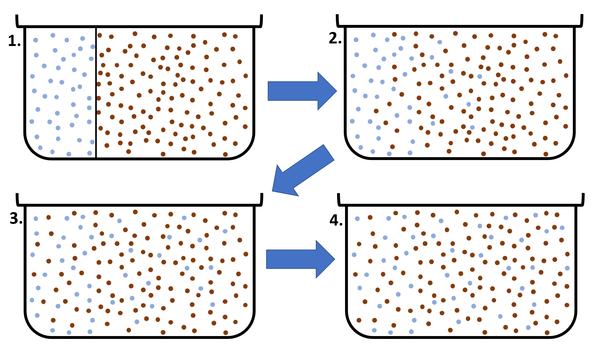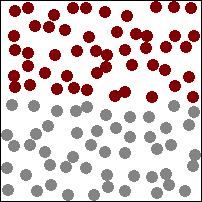Difference between revisions of "Diffusion"
(→Small Intestine) |
(→Meaning) |
||
| Line 25: | Line 25: | ||
==Key Stage 4== | ==Key Stage 4== | ||
===Meaning=== | ===Meaning=== | ||
| − | + | [[Diffusion]] is when [[substance]]s spread from a high [[concentration]] to a low [[concentration]] along the [[Concentration Gradient|concentration gradient]]. | |
===About Diffusion across a Membrane=== | ===About Diffusion across a Membrane=== | ||
Revision as of 11:27, 5 November 2018
Contents
Key Stage 3
Meaning
Diffusion is when particles spread from a region of high concentration to a region of low concentration.
About Diffusion
- Diffusion can only happen in a fluid which means a liquid or a gas because the particles can move past each other.
- Diffusion cannot happen in a solid because the particles are held in fixed positions.
- In diffusion the particles always spread from a high concentration where there is lots of the substance, to a low concentration where there is less of the substance.
- Diffusion stops when all substances are spread out equally and there is no longer a concentration gradient.
| This diagram shows a high concentration of blue particles on the left separated from the red particles by a barrier. When the barrier is removed the blue particles diffuse to the area of lower concentration on the right. Diffusion continues until all particles are equally spread. |
| This animation shows a high concentration of red particles initially at the top. When diffusion begins the red particles spread to the area of lower concentration at the bottom. Diffusion continues until all particles are equally spread. |
Key Stage 4
Meaning
Diffusion is when substances spread from a high concentration to a low concentration along the concentration gradient.
About Diffusion across a Membrane
- Diffusion in cells is a passive process which means it does not require energy to take place.
- When cells are surrounded by a high concentration of a nutrient then the nutrient will diffuse through the cell membrane and into the cells.
- When a cell has filled with a large number of waste chemicals they will diffuse through the cell membrane out of the cell.
Factors Affecting Diffusion across a Membrane
- Surface Area - The larger the surface area the more quickly diffusion can take place across the membrane.
- Thickness - The thinner the membrane the more quickly diffusion can take place across the membrane.
- Concentration Gradient - The greater the difference between the concentration on each side of the membrane the more quickly diffusion can take place across the membrane.
Adaptations for Diffusion
- The lungs and small intestine are specially adapted exchange surfaces that maximise the rate of diffusion.
Lungs
The lungs must be able to absorb Oxygen into the blood and release Carbon Dioxide from the blood back into the lungs.
- The lungs are adapted with thousands of alveoli which increase the surface area of the lungs.
- The walls of the alveoli separating the air from the blood are very thin.
- The blood supply to the lungs is very good to constantly supply blood with little Oxygen and a lot of Carbon Dioxide keeping a high concentration gradient.
Small Intestine
- The Small Intestine is long and folded to increase the surface area.
- The Small Intestine has structures called Villi which are extra folds in the surface to increase the surface area.
- The cells on the villi have microvilli which are folds on the cell membrane to increase the surface area.
- The walls of the villi separating the food from the blood are very thin.
- The blood supply to the villis is very good to constantly supply blood with little nutrients keeping a high concentration gradient between the food and the blood.

